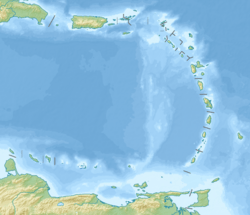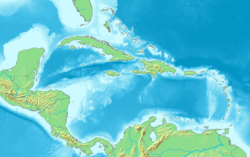Isla Magueyes facts for kids

Iguana at the marine lab on Isla Magueyes
|
|
| Geography | |
|---|---|
| Location | Caribbean |
| Coordinates | 17°58′08″N 67°02′39″W / 17.96889°N 67.04417°W |
| Archipelago | Greater Antilles |
| Area | 0.072 km2 (0.028 sq mi) |
| Administration | |
| Additional information | |
| Time zone | |
Isla Magueyes (which means Isle of Maguey) is a small island located very close to the southwest coast of Puerto Rico. It is about 7.2 hectares (or 0.028 square miles) in size. The island is only about 50 meters (164 feet) away from the main island of Puerto Rico.
The edges of Isla Magueyes are covered with mangrove trees. The middle part of the island has a dry, scrubby habitat. This is where the island gets its name, because many century plants, also known as maguey (Agave americana), grow there. The waters around the island have many coral reefs.
On the western side of Isla Magueyes, there are buildings that belong to the Department of Marine Sciences. This department is part of the University of Puerto Rico at Mayagüez. This university is a very important place for studying tropical marine science in the Atlantic Ocean. This is because of its great location, excellent facilities, and top researchers.
Animals of Isla Magueyes
Isla Magueyes is home to a special group of feral Cuban iguanas. "Feral" means they were once kept by humans but now live wild. These iguanas were released from a zoo on the island that closed in the 1950s. They now live all over the island.
Even though these iguanas are an endangered species in their home country of Cuba, they are considered an invasive species on Isla Magueyes. This means they are not native to the island and can sometimes cause problems for the local environment. Because of this, there have been discussions about reducing their numbers on the island.
To protect the iguanas, dogs, cats, and most tourists are not allowed on Isla Magueyes. This rule has made the island a safe place for many birds. It has become a kind of unofficial bird sanctuary. You can often see brown pelicans, cattle egrets, and herons here.
Scientists have used the iguana colony on Isla Magueyes for research. They study things like how animals communicate and how different species change over time through evolution.
See also
 In Spanish: Isla Magüeyes para niños
In Spanish: Isla Magüeyes para niños




